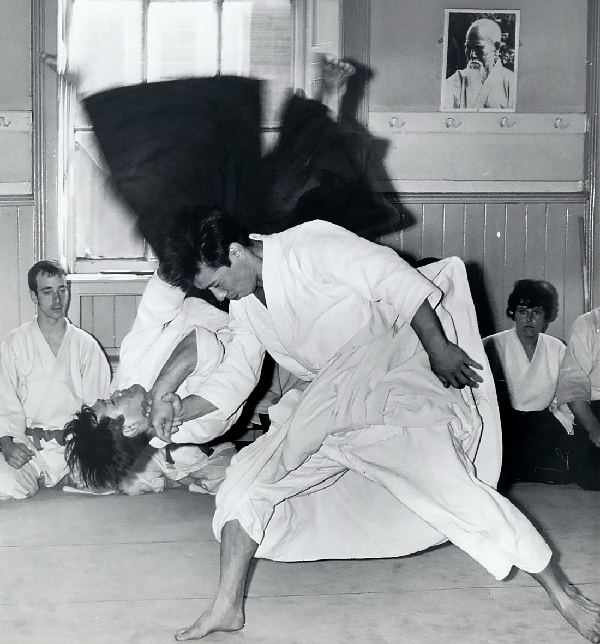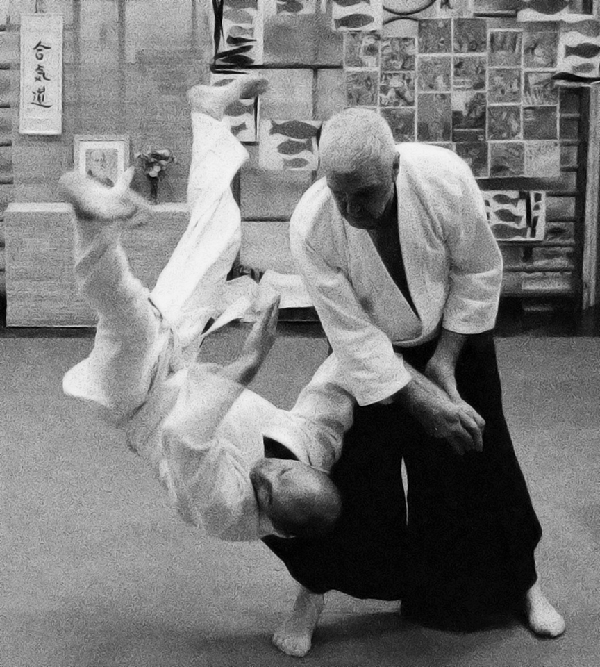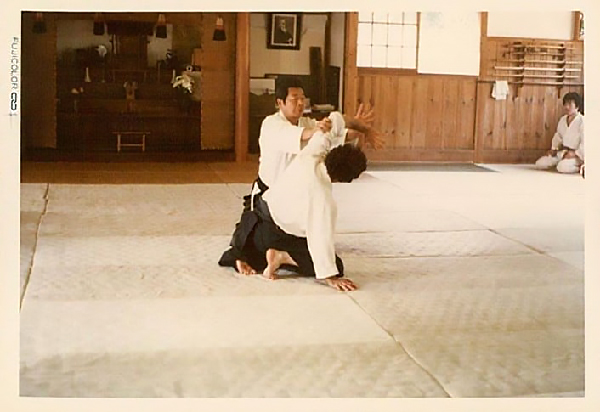In Aikido uke is regarded as a partner and is someone you train with, not someone you train on. An enigma perhaps but, the better one carries out the role of uke the better one's own Aikido will become. If one is just waiting for one’s turn to do the technique then it will be very difficult to learn Aikido.

Movement
Jumping through the air and falling is not what we mean by ukemi in Aikido. It is certainly good training, and one should practice falling and getting up in a solid forward, central, or rear posture facing forwards in the direction of travel or from the direction from whence one came. Many variations on this can be made, but it is still not what we are after. Ukemi is the receipt of technique – one must be immobilised or thrown to truly receive.
When receiving technique, the movement should emanate from one's centre. Do not collapse or fall over without good reason, nor jump before being thrown. In the beginning, learn to go wherever tori leads, lightly but firm, and without any apprehension. Next, get past the stage of knowing where one is going to fall - learn to trust tori. Skill at being uke is the single most important factor in determining one's aiki potential.
Flying ukes are fun to train with but one must never fall into the trap of believing it is one's own skill that makes them fly - it is theirs, and if you want that skill, you must fly too. Most of the criticism directed towards Aikido concerns practice where ukes fly too easily. The smart Aikidoka knows that it is but one method of practice where uke might be flying in anticipation of avoiding an incoming strike. Doing it is exhilarating but one must not stray too far from the basics. One needs to actively add energy to the attack and throw uke most of the time. Those ukes who clamp onto tori's wrist hard and resist all movement are usually doing what some jokingly call aiki Judo. Judo is an active art, they make technique on uke and speak of kuzushi and tsukuri, or actively breaking balance and making technique. Of course, it is possible to practice Aikido that way too but it is not the ideal. If uke decides to clamp on hard it is imperative that they press in and contact tori's centre thereby creating a real attack. Uke is not dead meat, uke should not just hang onto tori, uke is alive. We need to train realistically so that when attacked by the stereotypical knife-wielding madman, harmony will emerge from the chaos. Our initial movement will in part stem from our own uke training, and then we revert to tori to gain control. But, of course, if our technique is lacking, or the madman runs out of steam before his attack has chance to work, there is nothing wrong in using all our available kokyu-ryoku strength to take full advantage of the lull in his attack - just recognise that such is not the perfection we desire. But we do need to survive.

Receiving Learning
Taking Ukemi means to receive technique but in Aikido the role of uke is far more important than just that. Uke has to attack tori so completely that uke is in fact giving themselves to tori to play with. Tori learns to deal with this attacking energy, redirecting it this way or that. Simply, if there is no attack, there can be no technique in Aikido. Tori is not doing the technique on uke, rather, uke is doing it to themselves. This is the ideal, but a more realistic scenario is where tori and uke produce about fifty percent of the technique between them. What commonly happens is that uke’s energy runs out mid-technique, tori swings them around, and then splats them into the tatami - not quite perfect. Rather, uke’s energy should be active the whole time for good aiki to develop. Tori needs something to learn to manipulate. In the latter case, what happened was that tori overtook uke, tori

Submission
When receiving pain it is important that uke not grimace or shout uncontrollably. The expression should be normal, controlled; it is the tap that signals the pain. Uke uses two quick taps to signal tori that either, they cannot move, or, the pain limit has been reached. With a simple immobilisation like ikkyo there is often no pain. Here, uke tries to get up, fails, and signals such to tori by tapping and tori releases. If there is pain, then again, uke signals with two quick taps and tori releases. The reason for two taps is that it signifies deliberate decision. A simple tap could be mistaken as general noise within the midst of technique, such as when uke hits the floor with their hand or body when break-falling. If possible, uke taps against tori's arm, leg, or body as this best transmits the message. Failing that, uke taps against their own leg or body or, if lying prone, they tap the floor.
Uke Behaviour
When taking ukemi it is important to breathe. Holding the breath promotes stiffness and such is easily detected by tori. There are many things to remember when training yet some students actually stop breathing when practising. Instead of breathing naturally their breath becomes something akin to grunt. To get over this problem, always emphasise breathing out when practising break-falls. Next, from say koshi-nage, practise breathing out sharply when hitting the floor. And if game, tori can jump down on uke's chest, body-to-body Judo style, just after uke lands, which necessitates another sharp outward breath by uke for their self protection. Tori also breathes out to make the hit.
Uke should continually try to get up, albeit gently. If tori leaves a suki then uke should respond accordingly. Uke could simply escape, deliver atemi, counter, or just get up. For example, the pain of a wrist lock such as nikyo drives uke down, but if released uke should be up immediately. After being fully immobilised on the ground, on release uke should get up quickly; in fact, uke should aim to get up before tori, and tori should aim to prevent it by getting up first.
When repeatedly getting up off of the floor uke should maintain composure and alertness, not looking exhausted. When tired, just stop. Do not look tired, keep the breathing in rhythm. A good teacher ought to spot when one is tired and act accordingly. Training in this way will enable one to become immune to the shock of sudden pain and being able to bear it more will instil in an opponent an amount of uncertainty or self doubt.
The responsive aiki feeling between tori and uke also allows a psychological understanding to develop. One will instinctively know if one’s partner is happy, apprehensive, nervous, or not. Aikido develops this and after time, one will be able to gauge the feelings of others outside of the dojo a little more deeply. Finally, a good uke is someone who would use their common sense to simply avoid a life threatening situation.

Purpose
In time, your ukemi skill will lead to improved overall skill in Aikido. Also, you will figure out that it really helps with kaeshi-waza, or, returning the technique upon your partner (counters). Simply, if you go with the flow, you should/will learn to reverse that flow. And later still, you should be able to do your waza against someone who resists, or against someone who is trying to counter you. Then, you have it = aiki. But this does not work by magic. You have to plan your training accordingly.
You are not the most important person in the dojo. Your training partner is. They sacrifice their time, energy & body in order to train Aikido with you, for without them, you cannot train. Respect your partner!
